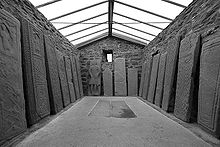Kilmartin Stones
The Kilmartin Stones are a collection of 79 old grave slabs (the exception is a slab from a burial box ) that are under a protective roof in the village of Kilmartin , Argyll and Bute , Scotland . The earliest are from the 13th or 14th century, the youngest are from 1707 and 1712.
description
Originally, the flat medieval panels covered graves. After the Reformation , many were relocated and in 1956 they were moved to a former mausoleum in the cemetery to protect them from weathering. The early stones (until the beginning of the 14th century) were the work of Irish stonemasons from Iona . Most of the stones are believed to have been the work of Loch Awe masons . Seven such tombstones were found on the Poltalloch Estate.
The symbolism of the motifs carved into the chronologically ordered panels is the subject of discussion and speculation. Many carry swords or claymores. Some stones have circular patterns of twisting or intertwined leaves. Some show armed men. Other motifs are crosses, animals and scissors; a comb appears with scissors on a stone. It has been suggested that some of the plates could be dedicated to the memory of Templars , but this is unproven.
- Kilmartin Stones
The Kilmartin Stones are managed by Historic Scotland. Additional tombstones can be seen at Kilmory Knap Chapel and Keils Chapel both in Knapdale , Iona Abbey , Ardchattan Priory, and Skipness Chapel (all in Argyll and Bute ).
There is a cross slab in the church of the village .
Web links
Remarks
- ↑ Claymore (from Gaelic Claidheamh-mòr, "big sword") mostly refers to the Scottish variant of the late medieval two-handed sword. It was used from the 15th to the 17th centuries
Coordinates: 56 ° 8 ′ 1 ″ N , 5 ° 29 ′ 13 ″ W.


